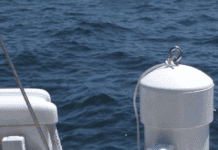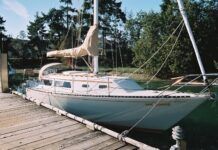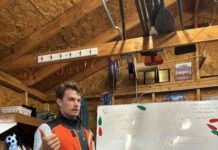Not so many years ago (or so we’d like to believe) getting a tan was a good thing, whether it was a carefully orchestrated rite of summer (phalanxes of beach chairs tracking the sun’s movement) or more the simple result of being outdoors as much as possible, clothed as little as possible. But… does the sun feel hotter these days, a bit less smooth, a bit more grating—or is it just us?
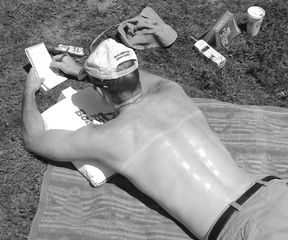
It’s not just us. In recent years, thanks to a gradual diminishing of ozone in the atmosphere, sunlight has indeed become more damaging. Add to that our better understanding of the links between exposure to the sun and skin cancer, and it’s a wonder we even dare go outside.
Sailors are subjected to UVA and UVB rays as much as anyone, especially in warm weather when shorts and short sleeve shirts are the norm. Even if you don’t accumulate enough damage to acquire melanomas, by far the most deadly type of skin cancer, and which cause 47,000 deaths a year worldwide, your skin will age prematurely.
It’s too late for Coco Chanel, but maybe not for you.
The Rays
Cancer is all about messed-up DNA codes in genes. A recent study by the Wellcome Trust Sanger Institute in Cambridge, England, published in the June 9, 2002 online edition of Nature magazine, found that 70% of skin melanomas appeared related to mutations of the B-RAF gene. This gene normally switches on and off, but when mutated, stays on all the time, multiplying continually, leading to cancer. Exposure to radiation is one way such a gene can mutate.
There are two types of ultraviolet rays emitted by the sun that cause skin damage. It has generally been held that UVA causes tanning and skin aging and that UVB causes sunburn and cancer. Now, researchers are not so sure of the distinction; there’s growing evidence that long-wave UVA also contributes to cancer. No matter. What’s important is that you protect your skin with a filtering agent that works with both UVA and UVB. One that is effective against rays of widely varying wavelengths is said to be “broad spectrum.” The wavelength of UVA is 315-400 nanometers; UVB’s wavelength range is 280-315 nanometers.
The Chemicals
There are two ways to protect skin from harmful rays: physical barriers such as clothing or application of an ointment such as zinc oxide or titanium dioxide; and application of a chemical barrier.
Once the most common chemicals used in sunscreens, para-aminobenzoic acid or PABA, has largely disappeared due to the incidence of skin irritations, allergic reactions, and because it had a tendency to stain clothing (as well as teak trim on boats). Many current sunscreens boast they are “PABA-free,” but today that’s not unusual. We tried only one sunscreen with PABA—Hawaiian Tropic’s Ozone 70 SPF, which also happened to be the orange among apples: We wondered if a product with 70 SPF and titanium dioxide would be markedly better than the SPF 30s in the main group. It wasn’t, at least not on the surface.
There are several families of chemicals that absorb UV and may possess other qualities that make them appropriate for use in sunscreens. Salicylates, for example, absorb only a small amount of UV but are highly water insoluble and skin sensitivity to them is rare. Among the salicylates seen on sunscreen labels are homosalate and octyl salicylate.
Other frequently used chemicals are cinnamate, oxybenzone, various benzophenones, and a fairly new one, Mexoryl SX. Writing in the Skin Therapy Letter, published by the University of British Columbia, Dr. Robert Bissonnette says, “Mexoryl SX is a new sunscreen agent with maximal absorption in the mid-UVA that also offers some UVB protection.” None of the sunscreens we tried contain Mexoryl, so it appears this chemical hasn’t found its way into many products yet.
Another chemical, however, has taken the skin care business by storm, and that is avobenzone, patented as Parsol® 1789, a registered trademark of the Givaudan-Roure Corporation. Used in skin care products abroad since the early 1980s, it was not approved by the US Food and Drug Administration (FDA) until April 1997. Of it Dr. Bissonnette says, “Most sunscreen agents only offer protection against short-wave UVA. Relative protection against long-wave UVA can be achieved by avobenzone (Parsol® 1789) and physical agents.”
The sidebar below shows the wavelengths, measured in nanometers (nm) of UVA and UVB, and some common sunscreen chemicals.
From these numbers one can see that only the last three ingredients come close to covering the entire wavelength range of both UVA and UVB. Of the three, titanium dioxide and zinc oxide are physical barriers, most often used in the form of lip balm because they are a solid color. Some manufacturers, however, now “micronize” these elements, so they’re not visible, and add small portions of them to conventional sunscreens. This leaves avobenzone, or Parsol® 1789, as the only sunscreen chemical that can legitimately be said to offer fairly broad spectrum protection. Many of our test samples contain Parsol® 1789, but not all. See the chart for the list of active ingredients.
As with many sciences, skin research sometimes creates more questions than answers. Some researchers caution that it’s a mistake to focus on blocking specific wavelengths of UV because it’s more sensible to consider all light coming from the sun.
SPF Ratings
SPF, or sun protection factor, is defined as the ratio of energy required to produce skin reddening through the sunscreen compared to the energy required to produce the same reddening without a sunscreen. (In scientific circles, this reddening threshold is called an MED, or minimal erythema dose.)
For example, if a given person on a given day can be exposed to sunlight for 30 minutes before reddening or burning, application of a SPF 4 sunscreen theoretically allows him to increase exposure to 2 hours before suffering the same reaction (1/2 hour x SPF 4 = 2 hours).
Application of a SPF 30 sunscreen should indicate safe exposure times approaching 15 hours, but experts caution that it doesn’t necessarily work out that way, for a variety of reasons. For one, the sunscreen probably won’t stay on your skin all day. Water-resistant sunscreens are supposed to last 40 minutes, waterproof sunscreens for 80 minutes. Then there’s sweat, rubbing off on towels and clothing, evaporation, etc.
Here are the percentages of UVB blocked by various SPF ratings:
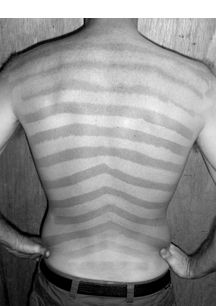
SPF 15: 92% UVB
SPF 30:96.7% UVB
SPF 40:97.5% UVB
Note that these ratings pertain only to UVB. So even a sunscreen with a high SPF rating doesn’t mean it will necessarily block UVA. To block long- wave UVA you need a physical barrier such as titanium dioxide, zinc oxide, or clothing.
In 1999, Congress mandated the FDA to issue a Final Monograph governing the manufacture and labeling of sunscreens because it was felt that the public was confused and in some instances misled regarding sunscreen performance. While most regulations were to have been in effect by May 2002, the FDA has delayed full implementation until December 2002, mainly at the request of several industry trade groups which want more studies conducted, primarily on the issue of UVA, which as noted earlier, may be responsible for more cancer than previously thought. One of the proposed changes will be to drop SPF numbers above 30 and to simply add a “+” sign to 30. The idea here is that SPF ratings of more than 30 provide only minimal additional benefit (see blocking percentages above) and may only serve to mislead the consumer into thinking it’s safe to stay in the sun longer than it really is.
To further clarify the SPF system, the words “minimal” may be added to SPF ratings of 2-12, “moderate” to ratings of 12-30, and “high” to ratings above 30.
A last point, however fine: Sunblock is any sunscreen with a SPF rating of 15 or higher.
Inactive Ingredients
Many sunscreen purchase decisions, we suspect, are made based on the marketing of the container, and on factors such as scent and consistency. This is where the inactive ingredients come in. Many include vitamins, like Hawaiian Tropic’s “exclusive time-released Vitamin A, C, and E Complex …to help nourish and moisturize your skin.” Ban de Soleil says its product “hydrates with botanical extracts and vitamin E.” Sea & Ski’s label reads: “It also contains astaZANTHIN® complex, a ‘super antioxidant’ 100 times more powerful than Vitamin E at fighting free radicals, to help maintain younger looking skin.”
The generic-looking Sav-On bottle bought at an Osco drug store, distributed by Albertson’s supermarket chain, lists other ingredients as water, sorbitan oleate, sorbitol, sorbitan stearate, glyceryl stearate SE, stearic acid, PVP hexadecene copolymer, hydrogenated vegetable oil, magnesium aluminum silicate, fragrance, jojoba oil, and a bunch of other stuff that won’t mean much to the average consumer (as if the foregoing, aside from water, did). Many contain some form of aloe.
As for the marketing, we’ve noted in the table under “Comments” the group to which it seems to us the product is being marketed. Pictures of frogs and claims of “cool watermelon scent” are clearly targeting children. Neutrogena’s no-nonsense label stresses integrity and targets natural-food sympathizers. Others, like Banana Boat and Coppertone Sport, have bright colors to appeal to young beachgoers.
Many labels imply that dermatologists or one cancer society or another endorse the product. Those claims, we suspect, are a bit misleading. Dermatologists and cancer groups do recommend using some type of sunscreen, but not usually a specific brand. It may be legitimate for a company to claim that its product is recommended, but it would be better if it said “along with everyone else’s.”
Of the 12 sunscreens evaluated, four have labels claiming UVA/UVB protection that do not provide broad- spectrum protection. Banana Boat Sport, Coppertone Sport, No-Ad, and Bull Frog Fast Blast Spray contain ingredients that provide protection against UVB and some UVA, but contain neither the physical barriers (titaniuim dioxide and zinc oxide) nor Parsol® 1789, that provide protection all the way up to 400 nanometers.
How to Use Sunscreen
Even the best sunscreens cannot protect your skin if not used properly. Here are a few things we’ve found over several years of testing. You’ve heard ’em before, probably from your mother.
Apply sunscreen at least 15 minutes before going outdoors. We’ve confirmed the value of this practice by applying sunscreen to one part of the body indoors an hour before going to the beach, treating another part of the body just 15 minutes in advance, and treating a third body part at the beach. Within a few hours the only burn-free area was that covered an hour in advance of going outdoors.
Reapply sunscreen after swimming or sweating profusely. Even water-resistant and waterproof lotions rub off by toweling dry. Instructions may call for reapplication after a certain amount of time, even if you haven’t been swimming.
Because higher SPF-rated lotions are more expensive, you can save a little money by buying several lotions with different SPF ratings, say an SPF 30 for children or fair-skinned friends, and a lower-rated lotion of, say, 4 or 6 for brief excursions. See the sidebar, “Which Sunscreen Product for You?” and remember that most dematologists will recommend maximum protection at all times, no matter what your skin type.
Also remember that using higher SPF-rated products doesn’t necessarily mean it’s safer to spend more time in the sun. Some studies show that skin damage can begin with one-tenth the exposure required to cause reddening or burning.
The PS Evaluations
The FDA Listing System for sunscreens contains about 2,800 different formulations and 12,000 SKUs, which would include different sizes and colors of the same formulation. Needless to say, we didn’t test all 2,800!
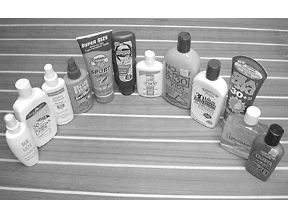
We visited several pharmacies and bought what seemed to be the more popular brands: Hawaiian Tropic, Ban de Soleil, Coppertone, Banana Boat, No Ad, Bull Frog, and others. We tried to get each with a SPF rating of 30, though a few are rated higher and lower.
We were unable to locate one product we’ve written about several times before—Nauticare (December 1, 1993, July 1, 1999), which was sold in a canvas “sun survival kit,” with various types of greaseless sunscreen and sunblock. Its website and phone number were not in service at the time we were procuring sunscreens for this evaluation.
The test was simple: We taped the back of our volunteer (a fair-skinned editor who tends to burn, not tan) with masking tape and applied the sunscreens between the stripes, using liberal amounts of each product and rubbing it in carefully and evenly. After it was “set” we peeled off the tape, waited 30 minutes, and sent the fellow outside to lie on his stomach for two hours in the noonday sun, like a mad dog or Englishman. Then we rinsed him off and checked for redness, and to see and feel how much lotion remained on the skin.
Results
Not surprisingly, areas of skin that received no protection were reddened; protected areas weren’t. The lack of variation between the treated stripes, however, was a bit surprising: We couldn’t see significant differences except in a couple of cases, which seemed to confirm the uniformity of the others:
Three of the products were applied high on the volunteer’s back, where there was already a slight tan and some freckles. While these three differed from the others, they didn’t differ much within their own set. Possibly the Bain de Soleil Oil-Free Protecteur, with an SPF of 25, fared slightly worse, although it was the top stripe in the most tanned area, and thus least likely to show much change.
After several hours out of the sun, the skin treated with Lifeguard was noticeably redder than it had been immediately after our volunteer came in from the blaze. This makes sense: Lifeguard was the only sunscreen with an SPF of 15—half the staying power of the others.
At least to the naked eye and the test subject’s nerve ends, the Hawaiian Tropic Ozone, at SPF 70, was not better than the SPF 30 products.
Two Products, the Hawaiian Tropic Ozone and the Banana Boat Sport, were very reluctant to be absorbed and blended into the skin; they seemed to maintain more of a phyisical barrier throughout the test.
Conclusions: Price Rules
The 12 popular sunscreen brands evaluated contain mostly the same chemicals. We favor the five that contain Parsol® 1789, which blocks long-wave UVA, although, as we’ve pointed out, we neither saw nor felt marked differences in protection. At least Parsol® 1789 provides protection against UVA up to its 400-nanometer limit.
The volume of products tested ranged from 4 to 16 fluid ounces. Because the FDA considers one application to consist of 1 ounce of product, it’s easy to figure how many applications you get from one bottle. It also makes the price per ounce a meaningful number; in our sample, prices ranged from just 50¢ per ounce up to $2.50 per ounce. That’s an astounding difference, especially for products that do the same thing essentially well.
If all of the SPF 30 products perform about the same, then it seems logical to choose a sunscreen based solely on price. The stuff isn’t cheap, and it can go fast, especially with a large crew aboard. There are other considerations, however. If you prefer spray over lotion, by all means go for the spray. And some people may have preferred fragrances.
Using the above factors, the least expensive sunscreen containing Parsol® 1789 is Sea & Ski at 81¢ per ounce, followed by Coppertone Sport Gel at $1.00 per ounce. Ban de Soleil, Neutrogena, Bull Frog, and Coppertone Shade are hideously expensive, each at more than $2 per ounce.
If you’re paying more than a buck an ounce for broad-spectrum sunscreen, it’s too much. Sea & Ski and Coppertone Sport Gel have the right stuff, and are priced right.
Also With This Article
Click here to view “Which Sunscreen Product for You?”
Click here to view “Wavelengths Covered by Various Sunscreen Chemicals.”
Click here to view “Value Guide: Sunscreen Lotions.”
Contacts – Bain de Soleil, Tampa, FL 33607; www.baindesoleil.com. Banana Boat, Sun Pharmaceuticals, PO Box 2260, Delray Beach, FL 33447; 800/SAFESUN; www.bananaboat.com. Bull Frog, Chattem, Inc., PO Box 2219, Chattanooga, TN 37409-0219; www.bullfrogsunscreen.com. Coppertone, Schering-Plough HealthCare Products; www.coppertone.com. Hawaiian Tropic, Ron Rice Beach Products, Box 265111, Daytona Beach, FL 32126-5111; www.hawaiiantropic.com. Lifeguard, Quest Products, PO Box 134, Clinton, AR 72031; 888/248-3469; www.questproducts.com. Neutrogena Corp., Los Angeles, CA 90045; www.neutrogena.com. No-Ad, Solar Suncare, Miami Lakes, FL 33017-3624; www.no-ad.com. Sav-On Osco, Robertson’s, Boise, ID 83726; www.sav-ondrugs.com. Sea & Ski, Faulding Consumer, Inc., PO Box 5587, Fort Lauderdale, FL 33310; 888/373-2754; www.sea-and-ski.com.






























